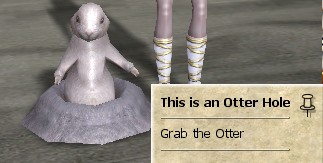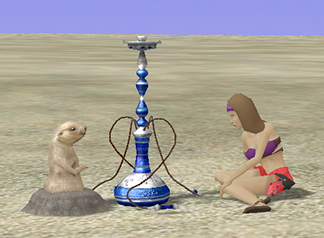Test of the Safari
Gharib's Speech
You know me as The Stranger.
I remember a time when I was young that disciples of The Human Body challenged themselves to take all that they had learned, and to create a Test for this generation.
New and unnatural games of sport were discussed, as were grueling contests of physical exertion.
In the end, one named Dragyn suggested that "To best test one's body, simply look to nature."
What Test could be more pure than to persue the very fauna that inhabits this land?
A simple wisdom that seems to have been lost on this generation.
Can a man outrun a Gazelle? Certainly not.
Grab a flying falcon? Never. Outwit a Fennec? Not a chance.
Out-dig an Otter? Hide like a Bullfrog? Creep like a Desert Rat, or move like an Ibis?
And so the challenge is set. The Test of the Safari asks disciples of The Human Body to capture and tag seven species of Egyptian wildlife.
A perfect blend of body and mind. Will this generation find that balance? I believe that the creatures of this land have little to worry about.
I give you: The Test of the Safari!
Note that though it was under the leadership of Dragyn that the Monument of Body was completed, the original idea is to be credited to Pandemonis, grandfather of Ankh-el-Pandemis, while it has been greatly enhanced by many Egyptians.
Test Details
In the Test of the Safari you will learn to track and capture seven species of Egyptian fauna. Each species has unique behaviors and tracking methods, and each must be accomplished four times. This Test is the one created by the previous generation (Tale1) and is inscribed on the Monument to the Human Body found at -449, 1958. The design text from Tale1 may be seen at The Test Of Safari, though a number of changes occurred during the Pittsburgh player meet and for implementation/gameplay reasons.The reward of this Test is to permanently boost your strength statistic - for every 4 animals you add to your logbook, you gain 1 strength.
Safari Guilds
- Safari Hunting Association: The Guild hall is at Nile Delta, east across the river from the chariot stop. The guild hall has two torches in front of it, and has been upgraded to the third level. The sole purpose of this hall is so that communication of sitings and during hunts can be managed without having to jump from tab to tab and to inform other members of locations of animals that they may not have completed.
The Animals
Bullfrog
Bullfrogs exhibit almost perfect camouflage, but their distinctive sound gives them away. High Dexterity helps capture these creatures.Bullfrogs can't be seen directly, you must locate them by sound alone. They may be found during the night starting about 6pm and disappear at 6am. They croak approximately every 30 or 60 seconds and may be heard from approximately the same distance as cicadas (~60 coords). They are found near water, at about fishing range. When you get close enough to one, you will see a small black spot on the ground (must have shadows switched on - see below) - look near Zintwana's feet in these pictures:
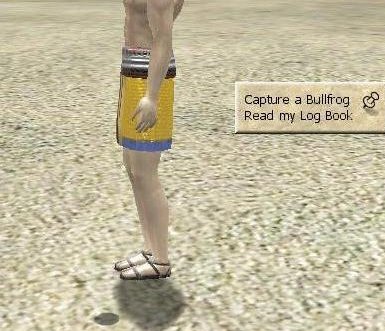 | 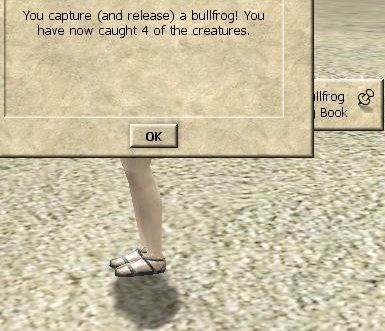 |
When you are this close, use the 'capture a bullfrog' option under the Tests menu. This has a 5 minute endurance timer.
Zintwana suggests the following strategy:
- Firstly make sure you have either stereophonic headphones or speakers working.
- Set yourself up so that when you hear a croak you are facing either east or west.
- When a croak comes it will usually be loudest in one speaker/earphone. Run in that direction about 10 coords and wait.
- When you hear another croak repeat until it changes direction.
- Now move back the direction you came but this time only 5 co-ordinates.
- Repeat until you get to a spot where you hear the frog croak equally as loudly in both speakers/earphones.
- Now turn 90 degrees and face north/south.
- Repeat the procedure until you again hear the croaks equally loud in both speakers/earphones.
- Look for the black spot on the ground nearby and grab the frog
Be aware that there may be multiple frogs in an area, which will make it harder to close in on a single frog - use the different volume levels to judge distance or maybe move so that both frogs are in the same direction, then find the closer one first.
A channel volume indicator may help those people who have partial or total deafness in one or both ears as this should then allow you to locate the frog.
For Linux users there is similar volume indicator named Ecasound. (Page states it supports Mac OS X also)
The black spot is caused by all objects in the world (even 'invisible' ones like frogs and oasis centres) having a marker object that casts a shadow. The marker object seems to be a candle model set below the landscape (presumably below sealevel). The black spot appears to be the up-cast shadow of this marker object - you need to have shadows turned on to be able to see it (util->video->shadow quality on any setting except the first one). Alternatively, if you have shadows switched off, pressing F4 for the direction arrow also temporarily switches on shadows (a good way of telling if what you see is a shadow or something else). This may be a bug and is almost certainly an unintended feature.
I found that I couldn't home in directionally on the frog that well with my headphones (mostly the sound came to left ear regardless of my position). But I was able to triangulate toward loud, louder, loudest! general area. Then, I went into the video settings and flicked shadows on and off as I moved a few coords around. Then, seeing the shadow from 3-4 coords off was easy as it turned on and off. - Osre
Desert Rat
Fast-moving Desert Rats blend perfectly with Egypt's terrain, but their distinctive tracks will lead to them every time. Be aware that the wind will cover up tracks over time.
Find some tracks in the desert, follow them to the end - the freshest tracks. There will be a black dot (like the bullfrog) where new tracks are appearing - place a trap at the fresh end of the trail.
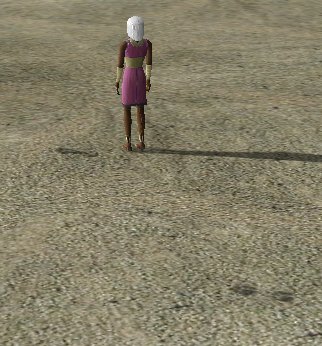
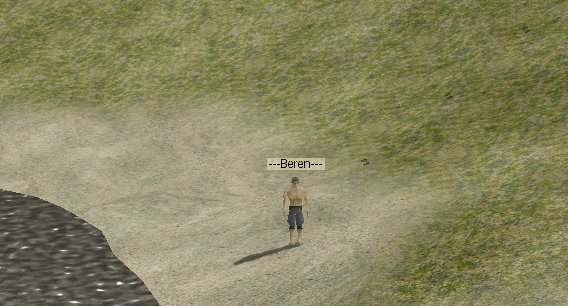
Rat tracks heading to water, they didn't come out the other side - BerenFresh tracks are very close together. Older tracks are wider apart, since the wind already wiped out part of the track.
The toes of the prints are pointing in the direction that the rat moved to. Every 10 seconds new tracks appear at the end of the trail. The first print I saw disappear was only after it was 1 minute old, but I also saw prints that lasted over an hour. -- Airmid.
N.B: When a rat is caught, the tracks don't disappear immediately, so it's possible to find an "empty" track.
You may build a rat trap for 1 canvas and 4 boards. (The option to build is found in your "Projects" menu, under "Tests -> Test of the Safari -> Set up a Desert Rat Trap".) It's not so much a building as an action with a cost and an Endurance timer. You must have the items in your inventory, but you get them back if you fail to catch a rat. When you catch one, you get message "You trap and release the Desert Rat, bringing your count to 1". The traps are not re-usable, as the four boards and one canvas disappear from your inventory if the attempt is successful. There is then a 50-60 second Endurance timer.
In order to see the animal tracks, you must have shadows switched on (util->video->shadow quality on any setting except the first one).
See Animal Tracks.
Falcon
To identify a Falcon Roost, drop a rabbit. A falcon will take it sometime within the next 5 minutes (but never within the first minute), and will fly off toward the nearest roost. Trees may be checked for roosts, but doing so is exhausting!
Drop a rabbit on the ground and wait for a falcon to take it (this may happen in the first minute, despite the university text). The compass direction the falcon flies off in will be reported. Dropping several rabbits in widely separated areas will allow you to triangulate the approximate position of the falcon's roost. Move closer and drop more rabbits until you have the falcon located to an approximate cluster of trees (+/- 50 coords), then search each. The closer the falcon is to its roost, the less likely it is that it will fly in the correct direction so you must search manually. Falcons will not pickup rabbits places within a 13 coordinate radius of a common altar.
To check a tree for a Falcon roost, you must have the "Fast gather wood" option turned off. (Utility...:One-click options). Checking a tree incurs a 2 minute endurance timer. A roost may be in any wood-bearing tree.
Scientists at Egypt's Great Universities of the Human Body have made some observations about Falcons, which they wish to share with those persuing the creatures.
They have discovered that falcons are clever animals, and will attempt to confuse those persuing them by not always flying directly toward their roost. If they have a long distance to fly, the scientists observed, then they will tend to take a direct path...
But the closer they are to their roost, the more their survival instinct kicks in.
- There’s a trick to getting better directions, though. I found a couple of exploits during the hunt, and had them fixed, but Teppy added an additional neat trick. If you place multiple rabbits on the ground, it appears that the one closest to the direction the falcon is located is picked up first. This may give you better directions than the simple compass direction, which can vary by quite a ways. My advice: set up several waypoints/expedition points that are far away from each other, but in the same region. Triangulate the general area, then head towards it. If you can get it within 10 trees, check them all, and get your falcon. -- Apophis
- It has been reported that Falcons will have survival instincts closer than 30 coords to their roost, an intersting data is that the sight radius of trees is of 48 coords. So if you drop a rabbit where there is no trees, or where a tree has just appeared, you wont be fooled. -- Airmid
- Who reported 30 coords? I dropped a rabbit 49 coords from the nearest tree and got a false result. Checking that tree revealed the falcon. -- Tamutnefret
- I used landmarks to record which directions were reported from which places while triangulating the approximate region of a falcon - Beren
- After you find your first falcon, theres a high chance the next few falcons are nearby, within 100 coords. Calqu
- I beg to differ the falcon never comes the first minute of the droping of the rabit, I droped it then about 15 secounds later it is picked up. It might be the fact that I droped one earlier and it took 3 minutes to get it and I went NE the direction it depicted and Droped a rabit, perhaps it was still on the way home ^.~ ~Zaphren~
- Falcons appear to change their nest. I did a series of readings from 3am-9am game time, and at some time in that interval the falcon moved completely out of the region I had previously bounded. -- Tamutnefret
- My falcon completely moved their nest - because somebody else found the falcon I was looking for! SanderDolphin
Khelben created this applet to hunt falcons : [FalconFinder]
Because Khelben is leaving the game the FalconFinder code is moved to my website (rdk):
The new links for the Falcon Finder tool are:
My observations of the Falcon Finder is that it appears to be out by up to 100 coords when you get very close to the tree - SanderDolphin
Fennec
Build a Fennec trap using boards and rope. Each night, traps on the outskirts of a pack will show signs of the creatures, and traps within 250 coords will capture one. At least four different subspecies of Fennecs must be captured and released.There are 7 subspecies of Fennec (a type of desert fox). They are :
- The Shorthaired Fennec
- The Pygmy Fennec
- The Sharp-Toothed Fennec
- The Ruddy Fennec
- The Furry Fennec
- The Bushy-Tailed Fennec
- The Brown Fennec
- Place a trap, wait till 4:00 AM or so. Foxes appear at a certain number of desert squares overnight. These squares only change for two reasons - the fennec has been captured, or the season changes. If your trap is within 1000 coords, you get a clue. If it’s both within 250 coords of that desert square, AND it’s the closest one to the fennec, you capture it. Be sure to check them every day, as they will escape within a short time. After 30 days the traps fall apart, which is fine, as they’re cheap. -- Apophis
- The position of the fennec nest moves each night, possibly this started after Teppy's fix. I found a movement of as much as 400 coords in 4 nights. So make sure you check all your traps again and again. One of my cages changed messages between 00:30 and 4:19 AM in the same night. So the moment that trap info is updated must lie in this period. -- Airmid
- New update: After I was able to catch the fennec, I could see that indeed signs of fennec were seen up to 1000 coords from the spot where I caught it. Also, cage messages were refreshed between 3:12 and 4:19. -- Airmid
- Like Ibis and Gazelle, several people can benefit from a single fennec find. I found "signs" that pointed to an area for Bushy-Tailed fennecs, and put five new cages in the likely area. I got one, then while running around to check the other cages to see their behavior, I got the exact same "success" popup. I made some of the unchecked ones public, and others were able to get a fennec. -- Jaby
- A trap that you released a Fennec from last night might capture another one tonight! -- Jaby
- Two cages that I placed after midnight showed no signs of fennecs at 4AM the same night, while one at least should have done so. Other cages I placed before midnight in the same night all got signs of fennecs. So I'm afraid we can't do 'quickies'. -- Airmid
See Fennec Catches and Public Fennec Traps.
Gazelle
Gazelles run faster than humans. The key to tagging a Gazelle is to tire it out. Strong teamwork is a must.
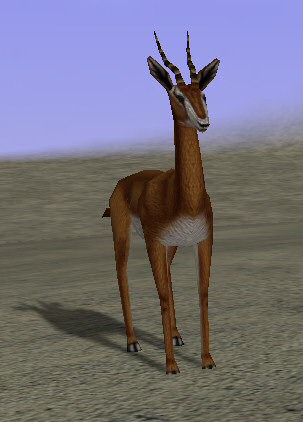 | 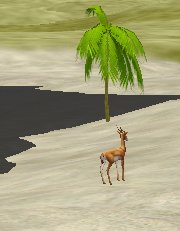 | 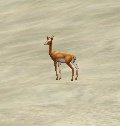 |
Bring friends - they’re fast. You have to herd them up and tag them. Gazelles travel alone, tend to be rare (except for the one that showed up on Newbie Island) and fast. Even lots of speed/dex won’t help that much.
When you get close to a gazelle (3-4 coords, just outside click range), it will run directly away from you at about twice top run speed for about 5 coordinates, then stop again. The key to catching them seems to be to make them run repeatedly without a chance to rest (ping-ponging them between players or terrain obstacles). Gazelles won't go into water, so herding them towards water is a good strategy. Be careful of running them at hills since they may be able to climb too-steep slopes, though possibly not extreme ones (the cliff at the edge of the map worked fine, but it has water at the bottom..). For moving it in a particular direction, a line or U-shape with outriders is effective - 3-4 people spaced about 4-5 coords apart can do this easily.
If you manage to tire it by ping-ponging it around, you will see a sparkle around the feet and someone will get a message in Main that the gazelle is breathing hard, then that it's about to collapse. After more chasing, it will stop running and hang its head (you may see another kind of flash) - the hunters should run up and tag the gazelle at this point (check your logbook to see if you got it - there is no message in Main). After a few second the gazelle gets it's breath back and runs off again.
Once the gazelle has been tagged by anyone, it will despawn in about 10 seconds (and may no longer to care about players - one was reported to run directly through a circle after being tagged). It may be possible to tag the gazelle before it's exhausted if you can get close enough to click it, but it is unlikely that anyone else will be able to if you do this.
Multiple people can currently tag a gazelle, but GMs have said this is a bug - the design was apparently that only 1 person should be able to tag it. Teppy may or may not fix this and has been reported as considering making it 3 tags per gazelle.
An undisturbed gazelle will stay still and appears not to despawn if you leave it for a while (one was left with no-one around for ~30mins while hunters ran in). They are visible from approximately 10 coordinates.
[Undisturbed gazelles stay there for a long time indeed. Waited for others to join in the hunt for more than one hour today, the gazelle was still waiting for us]
[I've seen an undisturbed gazelle vanish about an hour and a half after being reported. It was noon game time, which may or may not matter. -Leyic]
See Gazelle Sightings.
Ibis
Only one flock of Ibis inhabits Egypt. Tagging a single bird causes it to flee, but the rest of the flock is unfazed. The flock tends to move at night, and resettle in the morning.
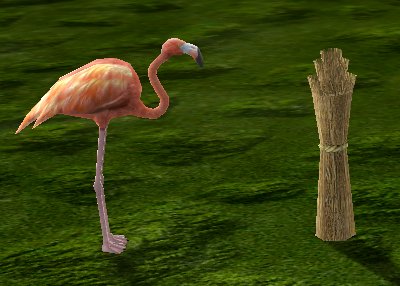 | 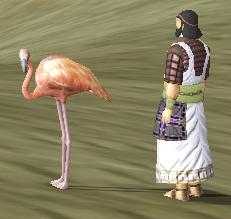 | 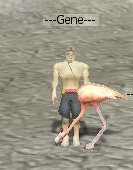 |
When captured you get one feather in your inventory. Only the Ibis you clicked disappears. You cannot catch more than one Ibis per Egyptian day (clicking another is safe - it won't disappear).
Ibis flocks number about two dozen, and the viewing range for an Ibis is 16 coordinates. The flock covers an area about 50 coordinates wide and vanishes at 6:00 pm, reappearing in the morning (one sighting of them appearing around 7.30am) in a new location.
See Ibis Sightings.
Otter
Otters build an underground network of tunnels. It is possible to put a stick (wood) down to block a portion of the network, but if too many holes are blocked, the Otter will get annoyed and eat a stick!Note: otter holes are blocked with boards, not wood.
An otter network has around 12 holes in the ground that are linked by tunnels. A hole has several paths underground to other holes. When you click on the otter, it will pop down the hole, follow one of the paths and pop up in another hole. You can block a hole with a board (the option appears when you try to catch the otter) and the otter will not be able to pop up in that hole. To catch it, you must block the holes that it can escape to from its current position. However, if more than 3 boards are blocking the otter, it will eat one of them and escape (note that you can have more than 3 boards in holes, but that the otter may not be blocked by more than 3 at any one time or will eat a board).
The 'smart' strategy for catching an otter is to chase the otter around the holes, mapping which holes are connected to which. When you have the network drawn out, chase it into a hole that only has 3 exits (it's ok to block holes to force it in the right direction), block those with 3 boards, then tag the otter. Marking the holes helps a lot when drawing the map. One way is to build a bonfire with one wood at hole no. 1, 2 wood at hole no. 2 etc. Another way is to stay in cartographic camera to avoid losing orientation.
A brute force method that will probably work (and probably be faster) is to just stuff a board in every hole you can, trying to grab the otter again and again. You'll get her eventually at a cost of some boards. Catching the otter is easy, once you locate it. Just keep putting a board into EVERY hole he leaves right after you try to grab him, and eventually, you will capture it. I used ten boards before I finally got the otter. (Halima, 29May05)
You can see the otter holes from about 12-15 coords away and after capturing the otter, they will disappear. How long an uncaptured otter will remain in one place is currently unknown, but it is no less than 1h45 minutes RL (Yeah, I've been 'that' slow.
Note that otters can appear in grassy areas as well as desert.
See Otter Sightings.
See Also: Animal Tracks, Ibis Sightings, Otter Sightings, Gazelle Sightings, Fennec Catches, The Human Body, Tests
